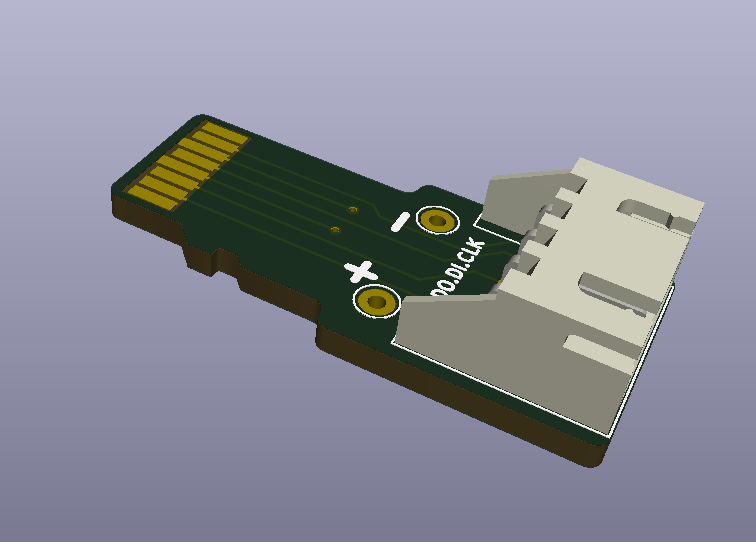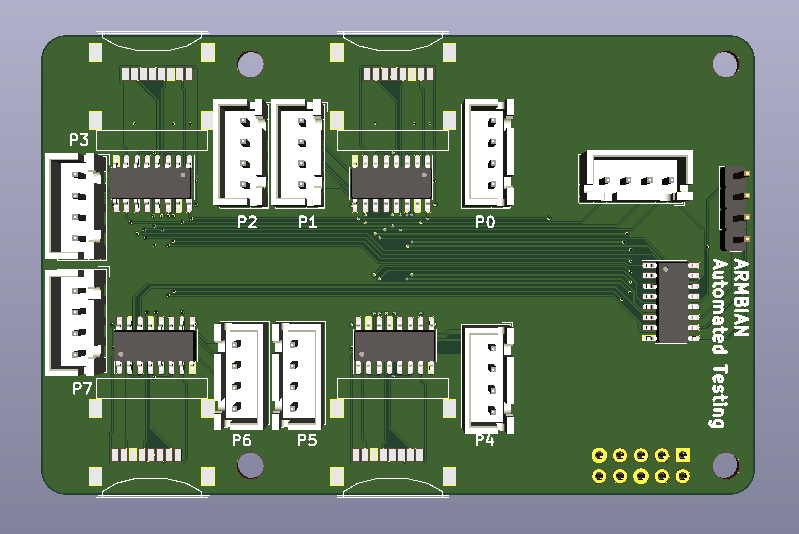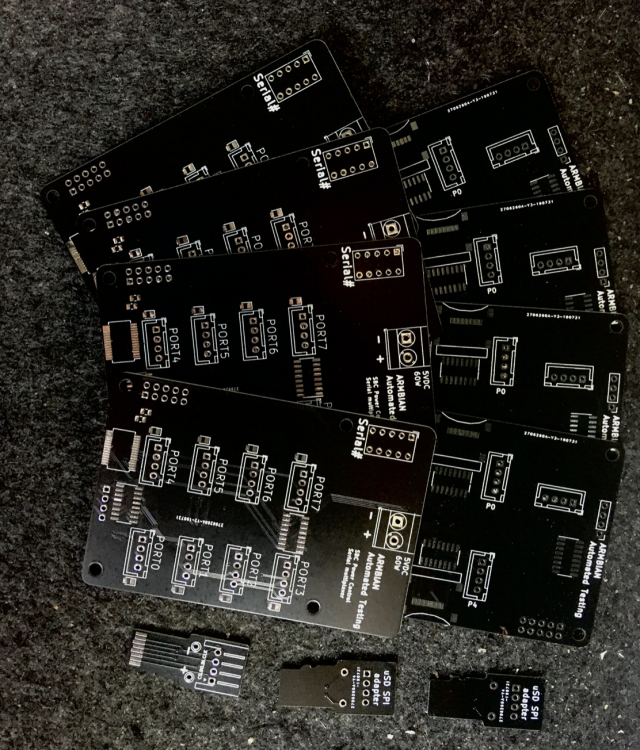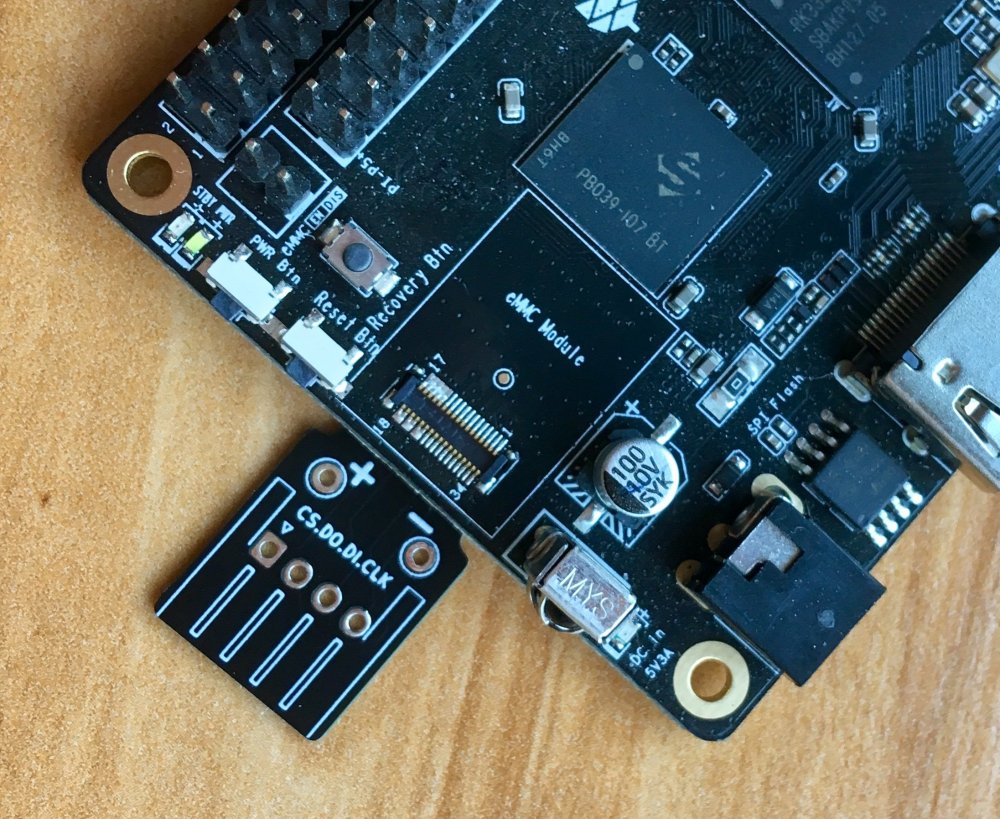-
Posts
74 -
Joined
-
Last visited
Content Type
Forums
Store
Crowdfunding
Applications
Events
Raffles
Community Map
Posts posted by Hijax
-
-
Order of stacking: to make 7seg LED visible, I.e.
SBC -> Blue -> Green
When stacked, SBC shall be powered from this sandwich top board connector. SBC thus shall be able to switch ports, what shall be reflected on 7seg.
7seg represents the port, serial lines (RX/TX) shall be routed to.
In princible via I2C we program 16bit word. Low byte is a power dsictribution, any of those bits control mosfets to power the connetced SUT SBC.
High byte is split into two 4bit chunks. Low control serial port mux, high are used by blue board to connect SD card.
Idea is, to be able to power all but one SUT-SBC, write data to SD card, release SD by SBC, power on specific SUT-SBC using the SD we just modifying, wait for RS232 communication to confirm booting went OK. In the meantine one can switch serial mux to other port to write something as terminal command.
-
Nice. But one 2x5 connector shall have long legs. To allow interconnection between boards/ stacking of them on top of SBC
-
I hear ZX spectrum :)
-
The distance between hats are about 22mm. Enough to open latch and remove / insert SD card.
Having said that, now I am not able but hopefully shortly Igor could check that.
-
29 minutes ago, Tido said:
Why did you choose the one with a hinge and not:
Hirose DM3CS (Hinge, Push-Pull, manual, without ejection mechanism)
Hirose DM3AT and DM3BT (Push - Push, with ejection mechanism)
Hirose DM3D (Push -Pull, manual, without ejection mechanism)
Can not recall now. I remember thinking about footprint. But also it may be this one was available at TME those days. From the other hand the cards are inserted once so way of installation is not so important. At least to me.
-
Just now, Tido said:
What about MOLEX_47219-2001 SD card connector - Second or 3rd party source?
I have sourced that from tme.eu
-
17 minutes ago, martinayotte said:
I think the 2 last parts, 74LS151 and 74LS157, should be HC not LS, since HC is 3.3V compatible but not LS which are 5V only ...
Very true...
-
@Tido no idea what country is yours
 but I can suggest ... use google for searching china pcb prototyping. I have recently used easyeda service, or jlcpcb. They manufacture 5 pcs (of each board, hence 3 times 5 pcs) for as little as 2USD plus delivery. Check their site. They can also do some basic assembly (I was not using that option yet, they can have some parts at their stock, anyway you may discuss the SMD soldering only as THT is simpe one)
but I can suggest ... use google for searching china pcb prototyping. I have recently used easyeda service, or jlcpcb. They manufacture 5 pcs (of each board, hence 3 times 5 pcs) for as little as 2USD plus delivery. Check their site. They can also do some basic assembly (I was not using that option yet, they can have some parts at their stock, anyway you may discuss the SMD soldering only as THT is simpe one)
Happens I have 4 set of boards (as I assembled one set only) and I can send those somewhere, to @Igor for example?
-
12 minutes ago, Tido said:
PS: I think the __MACOSX in the .zip is empty - it contains only some 212 bytes files.
Well, it is Mac OS resource "garbage" you can delete it.
-
@Tido et all, here comes the files of the project I started but had to suspend.
Firstly, as I by mistake did a short circut using the only board I have assembled.
Secondly - covid syndrome (the same number of tasks at work, twice the number of meetings and no workshop entry)
Anyway, latest files I have on my github. Zipped.
3 folders - 3 KiCad projects: source files, bom, other docs needed and so on.
Have a fun and stay healthy!
-
-
Hi,
My experiences with crontab @reboot is that I dropped that solution in favor of systemd services.
To give you basic idea here comes a excerpt of code I put into the customize-image.sh script:
cat <<EOT >|/usr/local/bin/usb3-memory-size.sh #!/bin/bash echo 1000 > /sys/module/usbcore/parameters/usbfs_memory_mb exit 0 EOT chmod +x /usr/local/bin/usb3-memory-size.sh cat <<EOT >|/lib/systemd/system/usb3-memory-size.service [Unit] Description=USB3 memory sizer Before=basic.target After=sysinit.target local-fs.target DefaultDependencies=no [Service] Type=oneshot RemainAfterExit=yes ExecStart=/bin/bash -c "/usr/local/bin/usb3-memory-size.sh" [Install] WantedBy=basic.target EOT systemctl enable usb3-memory-size.service
It creates a new service that corrects the kernel setting for USB3 camera.
This works perfectly fine.
When such a service shall be triggered depends on your configuration. Look at the line of [Unit] section, explicitly before/after lines.
For example you can force such a service to start after login prompt pops up.
-
Hi @lanefu, things go slowly for two reasons: problem with delivery of sdcard connectors and also lack of free time for soldering

Now, after summer time period, things hopefully will go in more planned & coordinated way. If you like, I can publish design documentation right away. Or just stay tuned, I do not drop this project, so i will update in one or two weeks status.
-
20 hours ago, guidol said:
he is searching how to enable I2S for Sound
My fault

-
As no details are provided I will suggest to:
1) verify i2c-tools package is installed
dpkg -l i2c-tools2) After successful installation (if needed) check if i2c bus is detectable
i2cdetect -l3) If working, play around with other i2c commands, like i2cset or i2cget
-
On 8/8/2019 at 3:45 PM, Igor said:
- (unsupported) Jessie is broken and has to be removed in a separate config
Jessie is not supported on Arm64 architecture. Is it really needed to continue from here?
On 8/8/2019 at 3:45 PM, Igor said:- lsb_release has to be checked if its 100% compatible with a Python version
Current shell script conforms to Python version but with no lsb_module analysis. Frankly speaking I do believe current shell is good enough.
-
Ok. Then next week I will spend some time in checking lsb_release
-
-
As for now I have not faced any issues with my SBCs and mini images. So my question is : what is next step before incorporating those changes into master branch ?
-
Thx @lanefu, as I already wrote I am also interested in that design, to sort out my shelf of SBCs and stop messing with SD cards.
That said may it be that in the future I can connect some of my boards (as I have dozen of not used ones) for continuous integration of future Armbian changes. In a automatic way.
So the question quickly pops up: I will continue with HW design but who will do the scripts that will use that HW? :) I.e. run compile.sh, upload to remote SD, power SUT, gather logs?
-
-
12 minutes ago, Tido said:
these 4 pin cable get locked with their hooks, right?
JST connectors shall be locked in place and not touched, yes. This is due to the need of having firm board-cable connection, also there is no need to disconnect that.
For power & serial cable, second end I plan to use 4 pin Dupont connectors. This time for easy plugging into SBC 40pin header.
Hence, together with uSD card adapter both can be reconnected as many times as one need.
-
First PCB from jlcpcb in on the way.
Meanwhile I have find some time to sit down on the mSD adapter.

Small PCB with JST XH connector. Thus cables between mux boards and those should be 4-Pin JST XH Female Connector Double Ended ones.
An micro SD mux board final design:

And serial mux / power distribution (with I2C interface)

For serial / power connection, standard NEMA17 extender cable (4-pin JST XH & DUPONT connectors) will do the job.
Dupont connector inserted into following pins on the SUT board:

I have ordered 1m cables (JST/JST & JST/Dupont) from aliexpress.
-
Fair enough. So this topic can be closed






THE testing thread
in Armbian build framework
Posted
Serial and power mux board is ready for ordering. However before I do so, I need to wait till SD card mux board redesign is complete at least overall idea is “approved”.
As previously written the major change is to switch from simple SDI interface towards SDIO one allowing full speed communication with card. This requires 8 pins thus not only mux board but also card adapter tuning.
Recently idea under consideration is to move SD mux board away from stacking and make it more alike USB Mass Storage device.